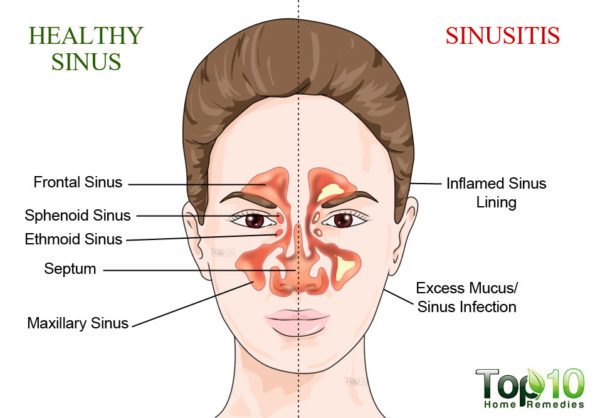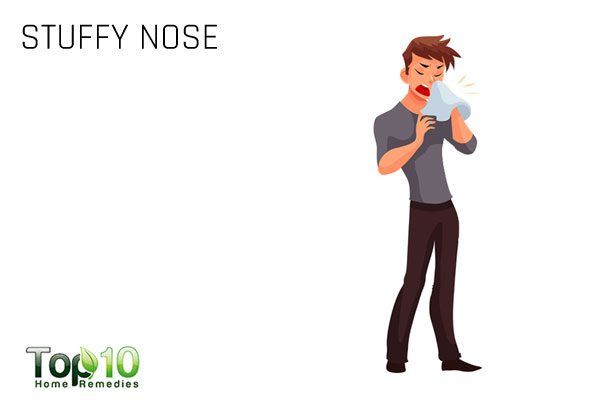A sinus infection, also known as sinusitis, is a very common upper respiratory tract infection that affects millions of people every year.
It occurs when your nasal cavities become swollen and inflamed. It is usually caused by a virus and often persists even after other upper respiratory symptoms are gone.

This type of infection may be acute or chronic. Acute sinusitis only lasts for a short time, whereas chronic sinus infections last for more than six to eight weeks or frequently recur.
An untreated sinus infection can potentially damage the sinuses and lead to ear infections, vision loss or even meningitis, so it is important to treat it right away. But treating a sinus infection is often delayed because people do not recognize a sinus infection in the initial stage.

Early symptoms of a sinus infection and a cold are very much alike, usually including a stuffy nose, slight fever, a scratchy throat, and feeling fatigued and just sick.
When it is a cold, the symptoms start improving in three to five days and you start feeling better within a week. But if symptoms persist for more than a week, you most likely have a sinus infection.
Here are some symptoms of a sinus infection that can help you distinguish it from a cold
1. Pain in Your Face
One of the best ways to distinguish between a common cold and a sinus infection is the pain and pressure you feel in your face with an infection.
Pain from a sinus infection can occur in and around your nose, in your upper jaw and teeth, and between your eyes. The accumulation of mucus in the sinuses also causes a feeling of heaviness or pressure in your face.
The pain may be worse when you move your head forward or touch the areas overlying your sinus cavities. Also, the maxillary sinuses located under your eyes may be painful when pressed or touched.
2. Yellowish or Greenish Discharge
Discolored nasal discharge – green, yellow or blood-tinged – is another sign of a sinus infection. This is mainly due to the virus in your system, which causes the discharge to change colors.
The discharge may also bypass your nose and flow down your throat, leading to tickling or itching sensations in the back of your throat.
Also, the discharge will be thick and hard to blow out of your nose. This is another major distinction between a sinus infection and a cold. The nasal discharge you experience with a common cold is clear and more liquid in nature.
When suffering from a sinus infection, you’ll find that you need to blow your nose more frequently to get rid of the thick accumulated mucus.
3. Coughing Up Phlegm
A cough often accompanies a sinus infection, but many people assume it is due to a cold or bronchitis.
Coughing due to a sinus infection usually is worse at night and in the morning. This is mainly because the sinuses drain down the back of your throat when you lie down, which triggers the cough receptor in the back of the nasal pharynx.
This type of cough also produces phlegm. Phlegm contains the bacteria or virus as well as inflammatory cells produced in response to an infection. The body tries to expel the phlegm that travels to your lungs through coughing.
You can reduce the frequency and intensity of your coughing by sitting upright to sleep. It will also help you sleep better, which is important for recovery.
4. Stuffy Nose that Lasts Longer
A stuffy nose is a classic symptom of both a sinus infection and a cold, but it usually lasts longer when it’s due to sinusitis.
This symptom is mainly due to inflamed blood vessels in the sinuses. Your inflamed sinuses may also make it difficult for you to breathe through your nose, giving you the feeling of a stuffy nose. Your voice may also sound “stuffy.”
To ease the problem, inhale steam or take a hot shower to thin the mucus so it’s easier to expel.
5. Headache
Another very common symptom of a sinus infection is a headache, but most people mistake it for a tension headache.
A sinus infection makes the nasal area as well as forehead feel so congested that it hurts and leads to a headache.
Also, the inflammation in the nasal area causes tightening of the muscles around the forehead and the top of your head, making the headache even worse. The headache can be unilateral (on one side) or bilateral (on both sides).
This type of headache usually gets worse when you bend forward and after waking up in the morning. The pain also can get worse if the temperature of your environment changes suddenly, like when it’s very hot outside and you enter an air-conditioned building.
6. Bad Breath
Bad breath, medically known as halitosis, is another common symptom of a sinus infection. In fact, they go hand in hand.
The back of the tongue, which resides in the throat, is home to bacteria that cause bad breath. During a sinus infection, excess mucus that is produced often slides down the back of your throat.
As the bacteria are bathed in mucus, it causes bad breath. This type of bad breath usually goes away once the sinus infection clears up.
To improve the smell of your breath, maintain oral hygiene by brushing twice a day and flossing once daily. You can also use a mint-flavored mouthwash.
7. Toothache
Believe it or not, pain in the upper teeth is a fairly common symptom of a sinus infection.
This pain is not an indication of an actual problem with a tooth. Rather, the pain occurs due to all the pressure building up in the sinus cavities in different areas of your face, which gives the impression of a bad toothache.








No comments:
Post a Comment